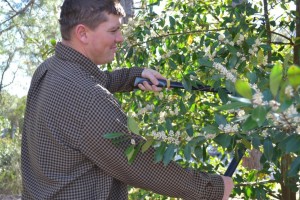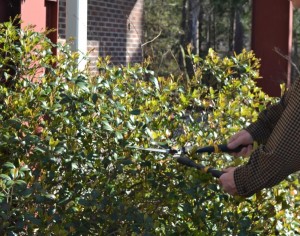As spring approaches, many gardeners get out the pruning shears and prune everything in sight. That might not be the best course of action! Take a look at these tips for flowering landscape shrubs to learn more about pruning techniques that will maximize amount of bloom.
Why Prune?
• Control plant size or form
• Remove damage (mechanical, disease, etc.)
• Prevent potential damage (overlapping branches, poor crotch angles, diseases, etc.
• Stimulate new growth (rejuvenate old plants, fill bare areas, increase flowering, etc.)
When to prune:
• Corrective pruning due to injury or dead tissue should be done as soon as evident.
• Avoid pruning from August 15 until plants are dormant.
• Most pruning should be done during the dormant season or immediately after flowering.
Rules of thumb:
• The “May Rule”.
• May defined if the plant blooms before May 1, prune immediately after flowering has ended (flowers produced on old wood or last year’s growth: Azaleas, Forsythia, etc.)
• If the plant blooms after May 1, prune during the dormant season (flowers produced on new growth: Crape Myrtles, Lilac Chaste tree, etc.).
• As with any rule there are exceptions: Oak leaf Hydrangea.
General rules of Pruning:
• Local in affect (usually within 6” of cut).
• Cuts should be made ¼” above a bud or to a crotch (Lateral branch).
• Cuts should be made at angles.
Pruning Equipment: (Make sure blades are sharp)
• Hand Snips (for small branches)
• Loppers (branches > 0.75” in diameter)
• Pruning Saw (limbs > 1.5” in diameter)
• Shears (for a more formal look)
• Pruning Knife (for clean-up)
Safe Pruning Principles:
• Keep equipment clean and in good repair.
• Appropriate, properly fitted safety equipment for job (eye and ear protection, no loose fitting clothes, etc.)
• Keep equipment within your control zone. Don’t over extend, know the limitations of your equipment and yourself.
• Know your surroundings (overhead utilities, other workers, etc.).
• Be able to identify Poison Ivy, Poison Oak, and other skin irritants.
Quick Tips to Remember:
• Pruning: Remove dead wood and seed pods annually during the dormant season.
• Size control should be done by cultivar selection, not by pruning.
• To promote a second set of flowers, prune away faded or spent flowers throughout the season.
For more information, click here for a UF / IFAS Extension publication on proper pruning techniques.
If you have any questions contact your local county extension agent.
by Eddie Powell – Walton County Extension Horticulture Agent
- Vegetable Garden Insect and Disease Management - June 10, 2015
- Insect Problems in the Heat of Summer - May 8, 2015
- Gardening in a Bucket - April 14, 2015

